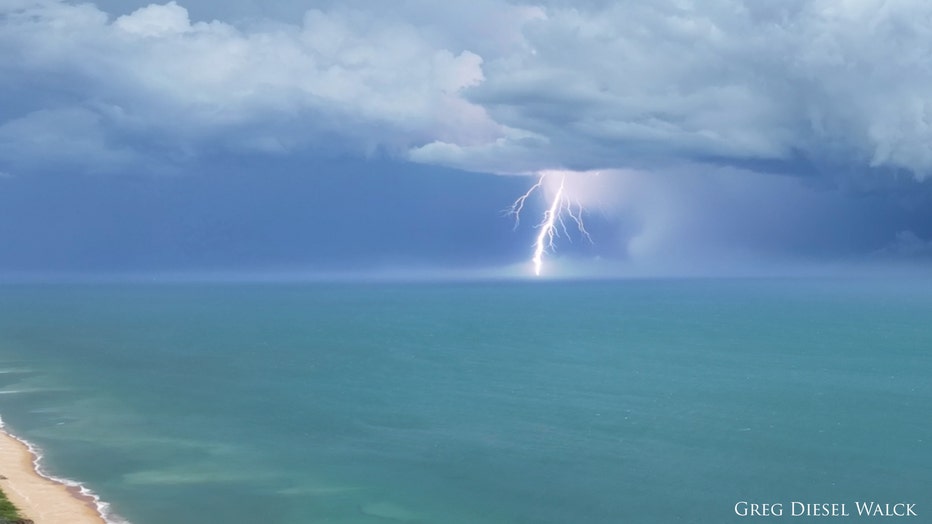Florida’s lightning is louder, stronger and more dangerous this week: Here's why
ORLANDO, Fla. - It’s not just your imagination — the thunder has been louder lately, the lightning strikes feel more intense and, yes, we’ve had more house fires because of it.
Earlier this week, several homes across Central Florida were damaged or destroyed by lightning-sparked fires.
Here's what we know about Florida’s lightning and why it's louder, stronger and more dangerous this week.
What's happening to the lightning in Florida?
What we know:
There has been a statistically unusual surge in positively-charged lightning — the rare, supercharged cousin of the typical lightning most of us are used to.
Positive lightning strikes account for only 5-10% of all strikes, according to the National Weather Service (NWS). This week, we've seen upwards of 30% of strikes being positive, which means a rate of six times the normal for these especially dangerous strikes.

Protecting homes during summer storms
Every year, nearly 25 million lightning strikes hit the ground in the United States. The Central Florida community has seen several of these strikes in the last few weeks, with two of them hitting and destroying homes. FOX 35's Marley Capper speaks with an expert on lightning protection systems.
What’s positive lightning, and why does it matter?
By the numbers:
Unlike more ordinary (negatively-charged) lightning, positively-charged lightning:
- Carries up to 10 times more electrical current, sometimes exceeding 300,000 amps. As little as 0.1 to 0.2 amps (100 to 200 milliamps) can be fatal, especially if it passes through the heart.
- Comes from the top of thunderstorms, often from the anvil or upper cloud deck between 30,000-60,000 feet.
- Strikes farther from the storm, sometimes hitting 10 miles away in clear skies with no warning — the infamous "bolt from the blue."
- Has a longer-duration discharge, which dramatically increases the risk of fire when it hits structures or trees.
- Recent FOX 35 Storm Tracker radar data showed more than 30% positive lightning in localized clusters depicted Tuesday evening, especially during collapsing afternoon storms.

FOX 35 Storm Team tracker radar data
Why is this happening?
Dig deeper:
A few factors are combining to fuel the uptick:
- Dry air aloft: When there's dry air above the surface, it enhances the charge separation in storms — a key recipe for positive lightning. Saharan dust has contributed to the presence of dry air, which can cause storm updrafts to be stronger and storm clouds to reach higher into the atmosphere. The taller the storm, the stronger the lightning.
- Small, fast-evolving storms: These can collapse quickly, shifting their charge structure and favoring stronger discharges.

Drone video: House destroyed after lightning sparks fire
At least three homes caught fire Sunday in Apopka has thunderstorms with wicked lightning passed over them. FOX 35 drone video shows one large home completely destroyed, gutted by the fire.
Weakening storms can be the most dangerous
Why you should care:
Collapsing thunderstorms can lead to more positive lightning, because the storm’s internal charge structure becomes unstable as it weakens.
Typically, a thunderstorm has a negative charge zone in the middle and a positive charge at the top. During the storm’s mature phase, strong updrafts keep these charges separated and balanced. But when the storm collapses, the updrafts fade.
This rapid weakening disturbs the balance, often exposing the highly charged upper regions of the storm — particularly the anvil — which can then release powerful positive lightning strikes. These discharges tend to travel farther and carry significantly more energy than typical negative lightning. Since there are fewer, less frequent flashes during a storm’s collapse, electrical energy can build up more intensely before finally being released in one large strike.
The result is the kind of long-reaching, high-amperage positive lightning that can strike miles away from the storm, spark fires and cause significant damage — even as the storm appears to be dying down.

Why does lightning cause fires?
FOX 35 Storm Team Meteorologist Laurel Blanchard breaks down how lightning can lead to fires.
What to expect later this season
What's next:
As we head deeper into summer:
- Storms become more moisture-rich, which generally reduces the percentage of positive strikes.
- However, tropical systems and late-season upper-level disturbances can still bring back the right ingredients for another spike — especially if they interact with dry air layers.
The takeaway
What they're saying:
According to the National Oceanic and Atmospheric Administration (NOAA), Florida leads the nation in lightning-related deaths.
FOX 35 Storm Team Meteorologist Brooks Garner is reminding locals that even small storms can be deadly, and weakening storms can be deadlier.
"Don't wait for a ‘severe storm’ designation to take action," he said. "With positive lightning, you don’t have to be under the rain to be at risk, and lightning can strike up to 10 miles from the storm. While your radar app may show a storm more than a 20 or 30-minute drive down the road, its lightning could easily leap out to reach you. So, when you hear it roar, head indoors."

(Credit: Photographer Greg Walck)
STAY CONNECTED WITH FOX 35 ORLANDO:
- Download the FOX Local app for breaking news alerts, the latest news headlines
- Download the FOX 35 Storm Team Weather app for weather alerts & radar
- Sign up for FOX 35's daily newsletter for the latest morning headlines
- FOX Local: Stream FOX 35 newscasts, FOX 35 News+, Central Florida Eats on your smart TV
The Source: This story was written based on information shared by FOX 35 Storm Team Meteorologist Brooks Garner and gathered from the National Weather Service (NWS), the National Oceanic and Atmospheric Administration (NOAA), the Occupational Safety and Health Administration, and the Multidisciplinary Digital Publishing Institute.

